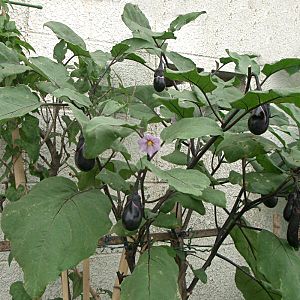Solanales facts for kids
Quick facts for kids Solanales |
|
|---|---|
 |
|
| Solanum melongena (Aubergine) | |
| Scientific classification |
|
| Kingdom: | Plantae |
| Clade: | Tracheophytes |
| Clade: | Angiosperms |
| Clade: | Eudicots |
| Clade: | Asterids |
| Clade: | Lamiids |
| Order: | Solanales Juss. ex Bercht. & J.Presl, 1820 |
| Families | |
|
|
The Solanales are a group of flowering plants. They are an order in the plant world, which is a way scientists group living things. These plants are part of a larger group called asterids, which are a type of dicotyledons. Dicotyledons are plants that have two seed leaves when they first sprout.
Some older names for this plant order included Polemoniales. But today, scientists mostly use the name Solanales. This group includes many plants you might know, from tasty vegetables to beautiful flowers.
Contents
What Are Solanales?
Solanales is a scientific grouping of plants that share similar features. These features often include how their flowers are shaped and how their seeds develop. Think of it like a big family tree for plants. All the plants in the Solanales order are related to each other.
Plants in the Solanales Order
This order contains several important plant families. Each family has its own unique plants, but they all share common ancestors. The main families in the Solanales order are:
The Nightshade Family (Solanaceae)
This is perhaps the most famous family within Solanales. It includes many plants that are important for food.
- Tomatoes: A popular fruit often used as a vegetable.
- Potatoes: A starchy root vegetable that is a staple food around the world.
- Peppers: From sweet bell peppers to spicy chili peppers.
- Eggplants: Also known as aubergines, a purple vegetable.
- Tobacco: A plant grown for its leaves, used in cigarettes.
- Petunias: Popular garden flowers known for their bright colors.
Many plants in the nightshade family contain special chemicals. Some of these chemicals can be helpful, like those in medicines. Others can be poisonous if eaten in large amounts. This is why it is important to know which parts of these plants are safe to eat.
The Bindweed Family (Convolvulaceae)
This family is known for its climbing plants. Many of them have funnel-shaped flowers.
- Morning Glories: These are beautiful climbing vines with colorful flowers that open in the morning.
- Sweet Potatoes: A root vegetable that is sweet and nutritious. Unlike regular potatoes, sweet potatoes are not in the nightshade family.
Other Families in Solanales
Besides the two big families, Solanales also includes:
- Hydroleaceae: These are mostly water-loving plants.
- Montiniaceae: A small family of trees and shrubs.
- Sphenocleaceae: Another small family, often found in wet places.
Why Are Solanales Important?
The plants in the Solanales order are very important to humans and nature. They provide food, medicine, and beauty.
Food and Medicine
Many of our daily foods come from this plant order. Imagine a world without tomatoes, potatoes, or peppers! These plants are a huge part of our diet. Some plants in this order are also used to make medicines. For example, certain chemicals from nightshade plants have been used to treat various health issues for centuries.
Beautiful Flowers
Beyond food, Solanales also give us many beautiful flowers. Petunias and morning glories are just two examples. These flowers add color and life to gardens and parks all over the world. They also provide nectar for pollinators like bees and butterflies.
Where Do Solanales Grow?
Plants from the Solanales order can be found all over the world. They grow in many different climates and environments. You can find them in tropical rainforests, dry deserts, and even in cooler, temperate regions. Their ability to adapt to different places shows how strong and diverse this plant group is.
How Do Solanales Reproduce?
Like most flowering plants, Solanales reproduce using seeds. Their flowers play a key role in this process.
- Pollination: Insects, birds, or even the wind carry pollen from one flower to another. This helps the plant make seeds.
- Seed Development: After pollination, the flower develops fruits that contain seeds. For example, a tomato is the fruit of a tomato plant, and it holds many seeds inside.
- Seed Dispersal: Once the seeds are ready, they are spread in different ways. Animals might eat the fruit and then drop the seeds elsewhere. Wind or water can also carry seeds to new places. This helps the plants grow in new areas.
See also
 In Spanish: Solanales para niños
In Spanish: Solanales para niños

